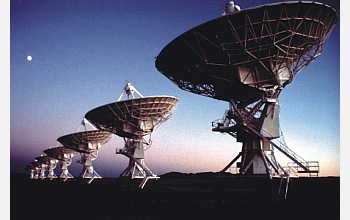All Images
Research News
Planetary Construction Zone?

An artist's depiction of the dusty disk surrounding nearby star system TW Hydrae. The disk holds vast swaths of pebbles extending outward for at least one billion miles. According to common theory, these pebbles are an early sign of the planet formation process, which begins when dust grains in a disk collide and accrete to form larger and larger clumps.
Credit: Bill Saxton, NRAO/AUI/NSF

The Very Large Array's twenty-seven operating antennae are spread throughout the plains of San Agustin, N.M. The receivers are currently being upgraded and refurbished to allow increased sensitivity and more efficient transmission of data. The task is expected to be completed by 2011.
Credit: NRAO/AUI


